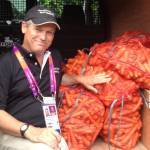Feeding the World

Many horse owners know that bringing elite racing and sport horses to international competitions is a feat of logistics, often involving air travel, quarantine, and many individuals along the way. But when a horse arrives a venue far from home, have you ever considered what they’re fed? It’s not as easy as running out the local feed store or the grocery to nab some carrots!
Consistency is key to managing healthy horses, especially in the midst of travel and competition. In the case of horses travelling internationally, providing the same feeds and hay isn’t so simple. There are lots of regulations on the import of agricultural products (consider how many potentially invasive seeds and bugs there could be in a single bale of hay!). This is where Kentucky Equine Research comes in. For the past 20 years, we’ve been the people behind the scenes working with feed manufacturers, National Federations, and regulatory agencies well in advance to ensure everything is taken care of so that when the horses arrive, their familiar feeds are here and waiting for them. We also manage the feed and bedding office in the stable area, keeping everything secure and delivering to the teams, while members of our technical staff are on site in case anyone needs assistance with their horse’s feeding program during their stay.
The 2010 World Equestrian Games (WEG) were held in Lexington, Kentucky, just a short drive from our corporate office in Versailles. More than 750 horses from 58 countries participated in the 16-day competition. Based on our work at previous Olympic Games, we were approached by WEG 2010 organizers to arrange feed, hay, and bedding for the competition.
Regulations imposed by host countries require different approaches for each competition we’ve been involved with. Because WEG 2018 is in the United States, we’ll adhere to rules set by the Food & Drug Administration (FDA) and United States Department of Agriculture (USDA) concerning the import of horse feed. These regulations cover issues such as bovine spongiform encephalopathy, also known as mad cow disease, and import of viable seeds from nonnative plants. For the 2010 event, we were able to work with many European feed manufacturers and national federations to organize a special shipment of 140 different commercial feeds.
Here are a few fast facts:
- At WEG 2010, about 15% of the competitors chose to bed their horses on wheat straw, while a handful used shredded paper or cardboard as bedding. Most of the horses were bedded on pine shavings, and over 11,000 bags of shavings were used.
- Eighty-eight tons of timothy were used at WEG 2010, compared to around 10 tons of alfalfa hay and smaller quantities of chaff and haylage. European teams preferred timothy as their primary forage, although horses from 27 federations also consumed haylage. Alfalfa was used by horses from 40 different countries.
- Horses went through more than 13 tons of carrots.








